Being a nature-oriented state, with dozens of national forests and parks it is unsurprising that Utah is home to over 621 species of spiders.
The six common types of spider families found in Utah are:
- Jumping Spiders (Salticidae)
- Funnel-weaver Spiders (Agelenidae)
- Comb-Footed Spider (Theridiidae)
- Orb-weavers (Araneidae)
- Wolf Spider (Lycosidae)
- Sac Spiders (Clubionidae)
The western black widow spider (Theridiidae family) can be deadly to humans.
Read on to discover each spider’s physical characteristics and the visual difference between males and females as well as when and where each species is most commonly sighted, what they like to eat, and their relations with humans.
Jumping Spiders (Salticidae) In Utah
Named for its improbable leaps and twitchy movements, the jumping spider or the bold jumper belongs to the world’s largest group of spiders, with over 6,200 species.
Identifying Jumping Spiders
While there are many different types of jumping spiders in Utah, they all share a few distinguishing features. They are small, less than a centimeter in length, with relatively short legs and a furry exterior. Of their eight eyes, two are prominent and their mouthparts are green.
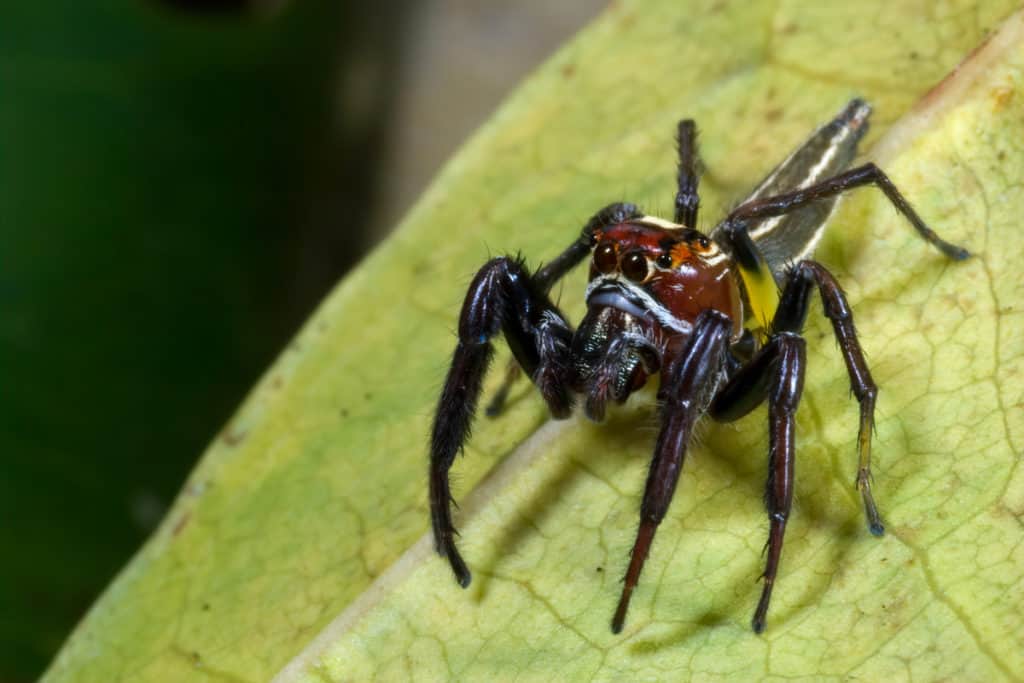
These spiders are typically brightly colored with reds, yellows, and reds, though males boost brighter coloration than females. Males also have hairy tufts over their eyes (like eyebrows) and modified front legs.
Jumping Spider’s Life Cycle
The jumping spider lays its eggs in June-July. The newly hatched spiders will make it through the winter as adolescents. Maturing into full adults around April-May, and starting the cycle all over again by laying their eggs.
Where And When To Find Jumping Spiders And What They Eat
Jumping spiders are commonly found inside and outside houses. They hunt during the day so they are easy to spot frequenting windowsills and railings. When it is dark or rainy, they will retreat to their webs.
These tiny harmless spiders spend their days hunting and eating insects and other small spiders.
If you are interested we have an entire article on the diet of jumping spiders including images of them consuming their prey. The article is called, What Do Jumping Spiders Eat?
Jumping Spiders And Humans
The jumper poses no threat to humans. They are helpful to have around the house, as they keep the pest populations down.
Funnel-weaver Spiders (Agelenidae) In Utah
According to Utah State University, the most common of the funnel-weaver spiders in Utah is the hobo spider and the grass spider.
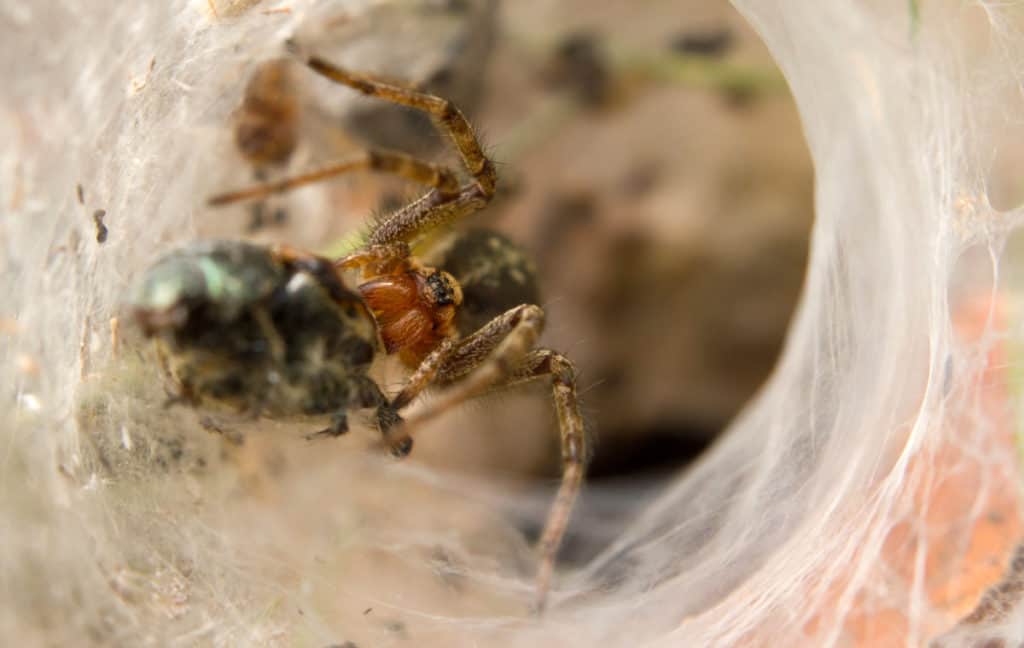
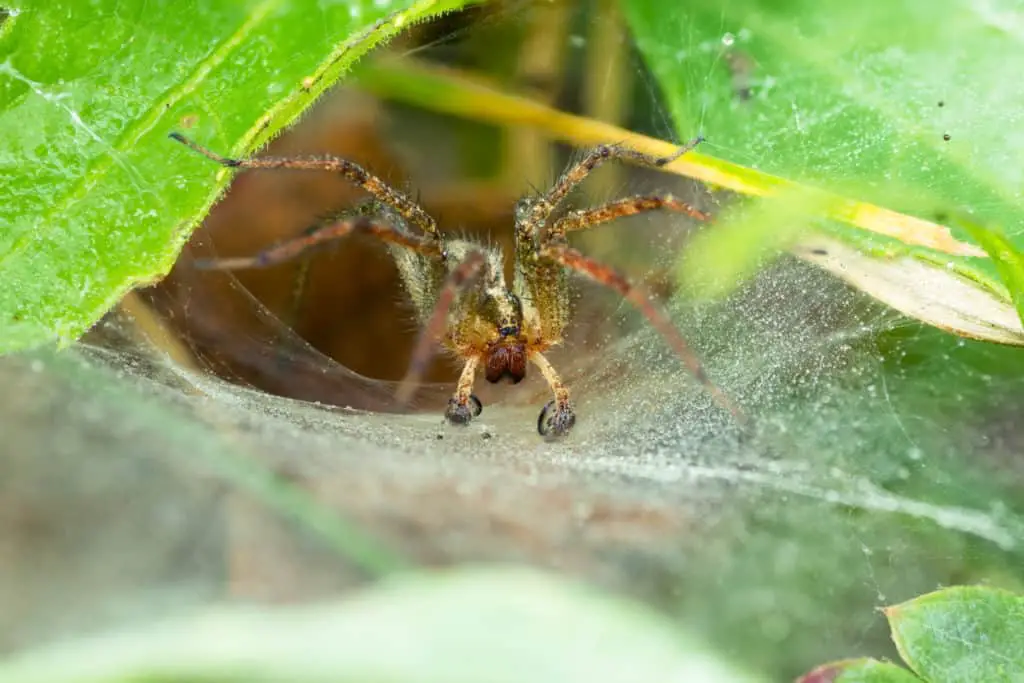
Identifying Features Of Funnel-Weavers
It is almost impossible to accurately identify the different types of Agelenidae without specific training and equipment. However, the most precise way to recognize a funnel-weaver is by their distinct web, which looks like a silk sheet with a funnel in the center.
They are fast runners and have a brown rusty coloring with patterning on their abdomen, hairy long legs, and club-like palps.
Adult female funnel-weavers can grow from 10 to 20 mm, while her male counterparts only grow 9 to 18mm long. Otherwise, there is no visible difference between the sexes (aside from the male’s papules).
Funnel-Weaver’s Life Cycle
Male spiders search for a mating partner from August to October. If he is successful eggs will be laid in the fall and hatch in the spring. The male dies after mating, but the female may live up to two years.
When And Where To Find Funnel-Weavers, And What They Eat
Funnel-weavers prefer to make their home outside on the ground in gardens and fields close to humans. Often found in tubs and sinks, the species tend to move indoors when the weather becomes cold or when they are looking for mates.
They build intricate funnel webs that look like sheets, that are not sticky but act as a trap for unwitting insects that wander in. In the close enclosure, the funnel-web spider can easily locate and attack its prey.
If you are interested in more information about the diets of spiders check out this article we have written, What Do Spiders Eat?
Funnel-Weavers And Humans
Humans considered hobo spiders to be a dangerous pest, largely due to the belief that the hobo’s bite is necrotic. However, there is no substantial evidence of hobo spiders venom causing necrosis or skin lesions.
Today the hobo spider has been taken off the CDC’s list of venomous spiders and the hobo spider, along with the grass spider, is considered to be beneficial.
Western Black Widow Spider (Latrodectus Hesperus) In Utah
The western black widow spider is part of this family. There are 32 species of comb-footed spider (Theridiidae) in North America many of these are residing in Utah. Named for the comb-like hairs on their legs, these spiders are often identified by their messy webs.
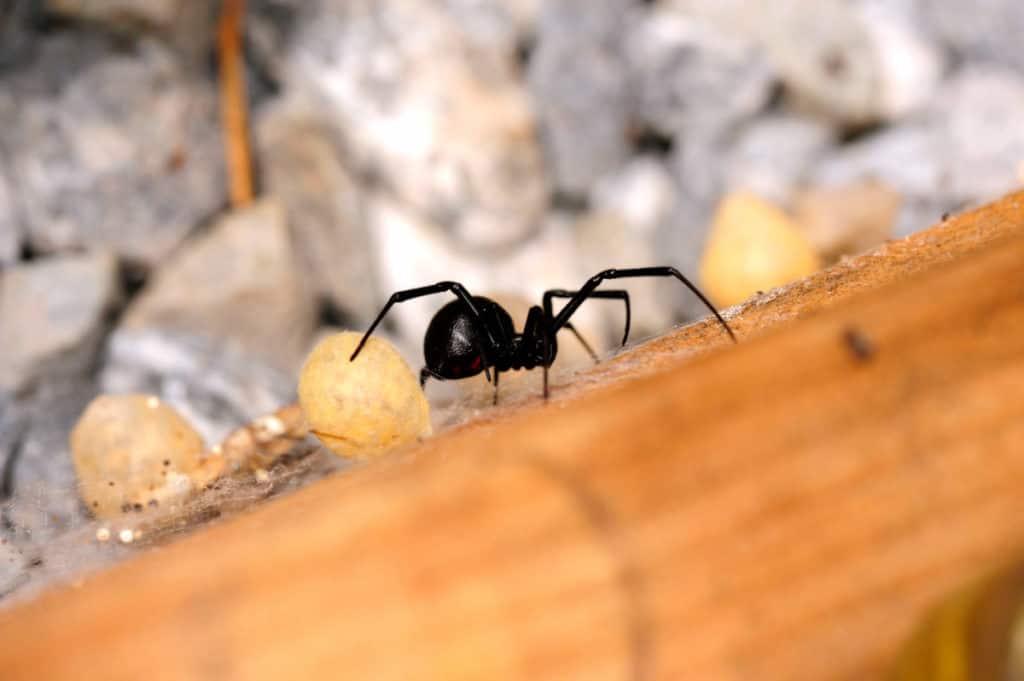
Although they are all similar in appearance and behavior the western black widow is the only one known to be dangerous to humans.
Identifying The Western Black Widow
The female western black widow has a smooth black body, a bulbous abdomen, and a red or orange hourglass on its underside and ranges in size from 14-16 mm.
The males tend to be less than half of the female’s size and look more similar to immature female spiders than to their adult counterparts. They are slimmer and their coloring is usually grey or brown.
The female black widow enjoys a relatively long life of up to three years, while the male lives a meager one to two months.
The Western Black Widow’s Life Cycle
The black widow spends most of her life alone, breaking its solitude in late spring to mate. Once mated, a female suspends the eggs on her web, where she can guard over them for 14 days.
Once hatched the spiderlings remain inside the egg sack for several days. Even after they emerge they will stay close to their mother’s web. This first month is hard on the spiderling, less than half of them survive.
Females typically take 4-6 months to mature. Males develop faster, skipping many of the female development stages. Temperature plays an important role in the rate of both male and female development.
When And Where To Find Western Black Widows And What They Eat
The widow spider usually chooses to live near the ground in pre-made holes and is most likely found in abandoned rodent holes, woodpiles, and garages. Given the option, they are likely to move indoors at the beginning of autumn or when the weather starts getting cold.
Inside they like to take up residence in cupboards, bookshelves, or any quiet dark place they can build their web.
Not an adept hunter, the western black widow eats insects caught in its web.
One of the prey that black widows will eat is cockroaches. If you are interested we have an entire article about the siders that eat cockroaches called, Do Spiders Eat Roaches?
Western Black Widows And Humans
While the black widow’s bite sounds petrifying for a good reason, they rarely result in death. If a person is bitten, it is almost always by a female protecting her web.
A black widow’s bite releases Latrodectus venom into its victim which is a mixture of neurotoxic proteins.
The most common symptoms include pain around the bite followed by skin lesions, muscle and chest pain, as well as stomach cramping and nausea, shortness of breath, and anxiety.
A few less typical reactions are an inability to speak, the swelling of limbs and eyelids, and a burning sensation on the bottom of the feet.
Orb-Weaver (Araneidae) Spiders In Utah
The “Charlottes” of the spider world, orb-weavers are defined by their classic spiral webs. The cat-faced spider is one of the most common orb-weavers.
Identifying The Cat-Face Spider
The cat-face spider can be easily distinguished by the depiction of a cat’s face on its back. It also has two pointed bumps protruding from its abdomen and a white line down its abdomen, usually crossed with V-shaped markings. Their colors are variable.
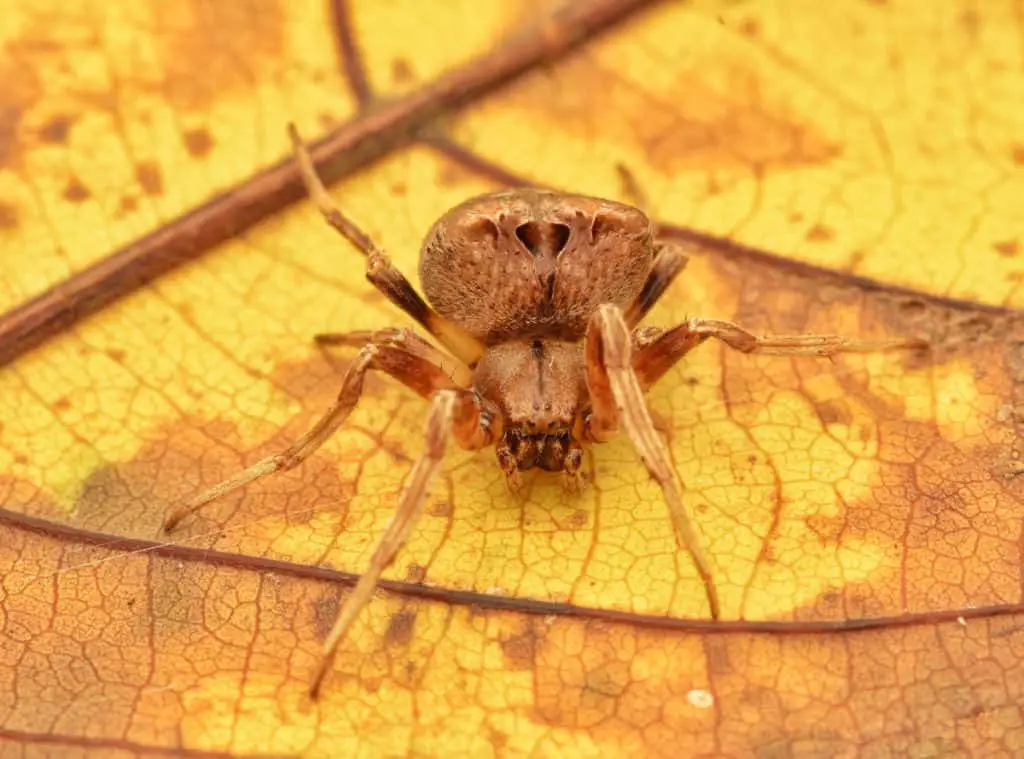
Females grow to about 5-7 mm long and males are about 2-4 mm.
The Cat-face Spider’s Life Cycle
For the cat-face spider, mating occurs in late summer. A female stores the male’s sperm and lays eggs later in the fall. If all goes well the eggs hatch in the spring.
If factors are favorable the female may even decide to produce another egg sac. But after the eggs are laid all of the cat-face spiders die. Only the unhatched eggs survive through the winter.
When And Where To Find Cat-face Spiders And What They Eat
The cat-face spider goes where the wind carries it after hatching. Weaving webs where it can find supporting structures. The spider’s main preference is for well-lighted areas, staying near porch lights or windows. This is probably because their flying insect prey is attracted to light.
Cat-face spiders are the most frequently observed between August and September, completely disappearing in the winter.
Cat-face Spiders And Humans
Cat-face spiders have little to no contact with humans and when they do is unlikely that their fangs would be able to pierce human flesh. Making them a handy mosquito catching addition to any porch.
Wolf Spiders (Lycosidae) In Utah
Another species that has an unsubstantiated reputation for being poisonous, the Wolf spider is frequently found in Utah.
Identifying Wolf Spiders
Wolf spiders have large hairy bodies colored in earth tones in a mottled pattern, growing up to 35 mm. Although they have eight eyes, wolf spiders are recognizable for their two large eyes set over a row of four smaller ones. They have long legs that end in distinctive microscopic claws.
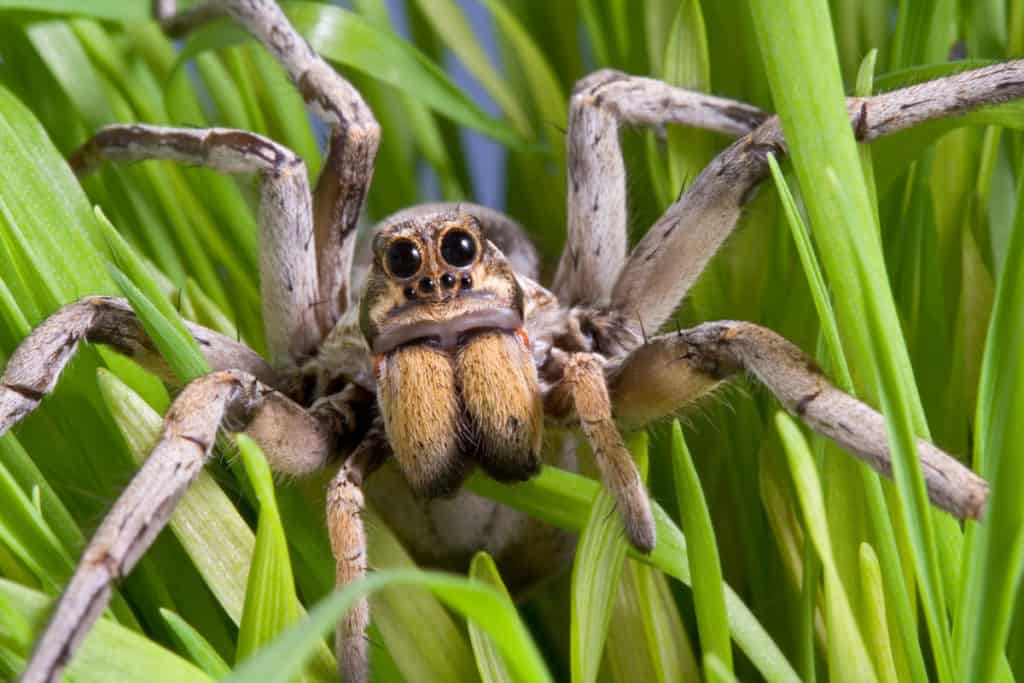
The only visible difference between males and females is (like almost all spiders) the males’ enlarged pedipalps.
The Wolf Spider’s Life Cycle
In Utah, most wolf spiders mate between May and August. The male dies after mating, while the female can be seen carrying around a silken egg sac attached to her abdomen. After the eggs hatch and the spiderlings crawl onto their mother’s back and stay there until they are big enough to hunt on their own.
Females can live several years longer than males.
When And Where To Find Wolf Spiders And What They Eat
Wolf spiders live on the ground, in gardens, woodpiles, holes, or anything they can crawl under. Some types of wolf spiders are more commonly seen in people’s lawns during spring and summer.
Like many spiders, wolf spiders move indoors around the end of August. Opting to live near windows, doorways, or basements.
They capture their prey by chasing or ambushing it, typically eating other spiders and insects.
Wolf Spiders And Humans
Although it is a persistent belief that wolf spiders have a necrotic bite, there have been no confirmed cases. Wolf spiders will bite if threatened. Their bites usually produce nothing more than redness and irritation, unless the bitten person has an allergy.
Despite their intimidating appearance, many gardeners welcome wolf spiders. As they are a free and effective form of pest control.
Yellow Sac Spiders (Cheiracanthium) in Utah
The most common sac spider found in Utah is the Yellow Sac Spider. Unlike the hobo or wolf spiders, the sac spider lives up to its reputation for having a bite poisonous to humans.
Identifying The Yellow Sac Spider
The yellow sac spider is unsurprisingly yellow, though some appear more green or white. Its jaws and mouthparts are dark-brown. There is a dark stripe running the length of the spider’s abdomen. The tips of the sac spider’s legs are black as though it walked through ink.
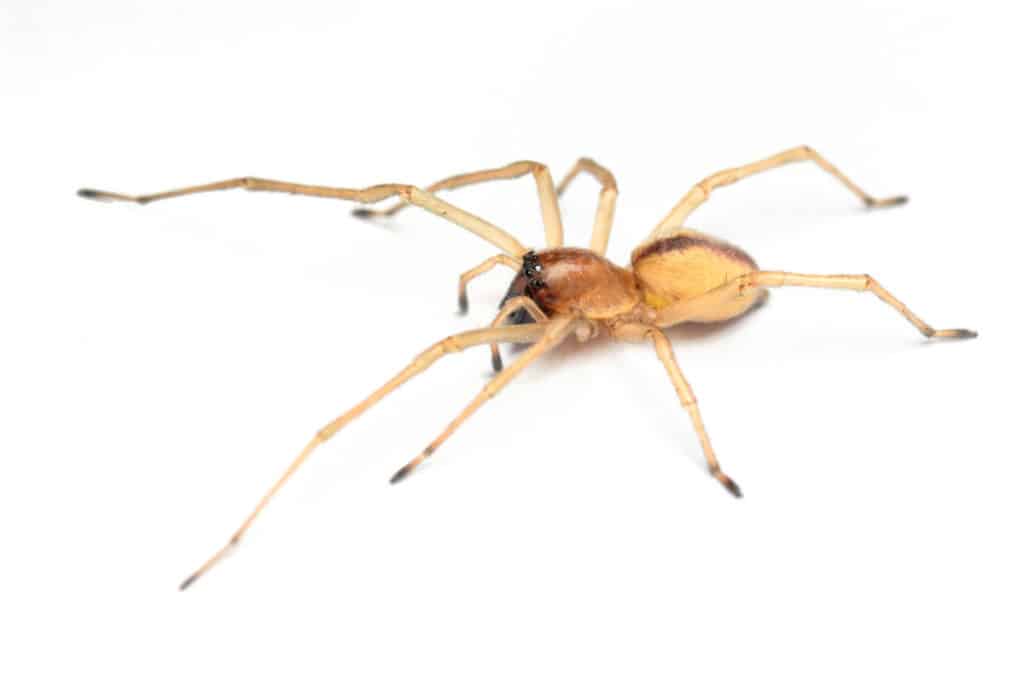
Females reach anywhere from 5-10 mm and males 4-8 mm. Though the males tend to be darker and leaner.
The Yellow Sac Spider’s Life Cycle
The female sac spider will lay her eggs any time from June to early autumn. These sacks are usually hidden in houses and guarded over by the female. After hatching the spiderlings stay with their mother for another 17 days.
Males take about 119 days to mature and females take 134 days. Both gender development rates are affected by environmental factors.
When And Where To Find Yellow Sac Spiders And What They Eat
The sac spider is a household spider and can be found year-round. Though adults are more frequently seen outside from April to October, where they ideally live in trees or shrubs close to open spaces.
These spiders are nocturnal, they spend their night hunting insects and smaller spiders. During the day they sleep in small web sacks that are tucked away on windowsills, where the ceiling and the wall meet, or under leaves.
On a side note, look for spider poop when trying to establish if you have spiders in your house. We have an article on this topic of spider poop, check it out if you are interested, Do Spiders Poop?
Yellow Sac Spiders And Humans
The yellow sac spider is attributed to more human bites than any other spider. These bits are painful and produce a burning sensation along with a rash. Other symptoms are; fever, nausea, and muscle cramps. Though these are not pleasant symptoms, sac spider bites are not fatal.
The Wrap Up
There are hundreds of other interesting spider families living in Utah such as Crab Spiders (Thomisidae), Woodlouse Spiders (Dysderidae), Crevice-weaving Spiders (Filistatidae) to name a few.
Out of all these spiders, only the western black widow poses a medical threat to people.
So if you are in Utah chances are the spider lurking in your shower is doing more good than harm.
Sources
https://stateparks.utah.gov/wp-content/uploads/sites/13/2020/06/Spiders-General-Info-USU.pdf
https://extension.psu.edu/bold-jumper-spider
http://bohart.ucdavis.edu/uploads/5/6/2/5/56256413/note_12_jumping_spiders_print.pdf
https://www.ksl.com/article/27936190/spiders
https://extension.usu.edu/pests/schoolipm/structural-pest-id-guide/hobo-grass-spiders
https://s3.wp.wsu.edu/uploads/sites/2061/2014/01/HoboSpider.pdf
https://extension.colostate.edu/topic-areas/insects/western-widow-spider-5-605/
https://www.livescience.com/39919-black-widow-spiders.html
http://www.wci.colostate.edu/Assets/pdf/Cat-FacedSpiderOct16.pdf
https://www.inaturalist.org/taxa/214058-Araneus-gemmoides
https://extension.usu.edu/pests/schoolipm/structural-pest-id-guide/wolf-spiders
https://www.healthline.com/health/wolf-spider-bite
https://usaspiders.com/cheiracanthium-mildei-northern-yellow-sac-spider/
